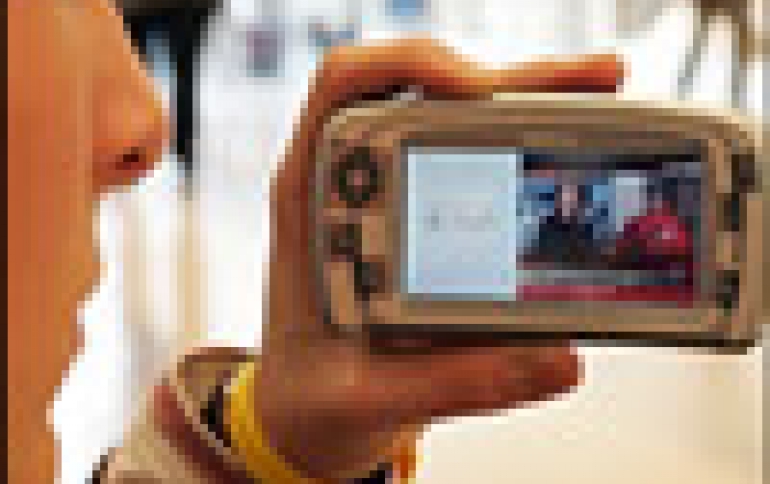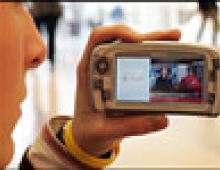
Soccer World Cup not Likely to Kick Start Mobile TV
Visions of a nation of soccer fans glued to broadcasts via mobile phones of this summer's World Cup are unlikely to come true, industry players said at this year's CeBIT trade fair.
Telecoms operators and phone makers had hoped the month-long event that starts on June 9 would spark sales of multimedia handsets and tempt customers to use expensive interactive services such as betting during games.
But a failure to agree on what transmission standard to use among Germany's 15 regional media authorities has delayed plans for the matches to be sent to mobile customers nationwide in broadcast quality.
Instead, more limited, local trials will take place in some regions, while T-Mobile customers will be able to watch live coverage of some games and clips of others using the current third-generation UMTS mobile phone standard.
UMTS, as opposed to broadcast technology, has the disadvantages that it can be slow and that networks can jam if too many customers try to download signals at once.
"I think there was too much euphoria," Ralf Schaefer, head of image processing at Germany's Fraunhofer Institute at CeBIT technology trade show.
"The World Cup is obviously a good opportunity, but the technology is very young," he added.
The Fraunhofer, which helped develop the GSM mobile phone and MP3 mobile music player digital standards, is working on a new project designed to harmonise UMTS and the two vying mobile broadcast standards -- DVB-H and DMB.
DVB-H is favoured by all the major telecoms operators and is mainly in use in the north of Germany.
DMB is more widely available and will be used for some broadcasts during the World Cup, but at the moment it can only broadcast four channels and does not have the same lucrative interactive possibilities that operators are keen on.
Schaefer is confident the Fraunhofer's new standard, called DXB (digital extended broadcasting), will be ready by the end of the year. "Once the World Cup is over, people will start thinking again," he said.
SMART BALL
Another technology that failed to grow up in time for the World Cup is the so-called smart ball -- a football with a chip inside designed to rule out mistakes on goal-line decisions.
FIFA said in December the system, which was developed by Adidas in conjunction with the Fraunhofer and German firm Cairos AG and was being tested in the run-up to the tournament, was not yet ready.
The smart ball contains a 1.5 centimetre (0.6 inch) chip that sends out a radio signal when it crosses the touchline. That signal is relayed in less than one second by antennae at the stadium via a computer to a watch worn by the referee.
But the ball was conspicuously absent amid a slew of World Cup-related gadgets and services on the Fraunhofer's stand at CeBIT, and a spokeswoman for the institute said she had instructions not to talk about the subject.
But a failure to agree on what transmission standard to use among Germany's 15 regional media authorities has delayed plans for the matches to be sent to mobile customers nationwide in broadcast quality.
Instead, more limited, local trials will take place in some regions, while T-Mobile customers will be able to watch live coverage of some games and clips of others using the current third-generation UMTS mobile phone standard.
UMTS, as opposed to broadcast technology, has the disadvantages that it can be slow and that networks can jam if too many customers try to download signals at once.
"I think there was too much euphoria," Ralf Schaefer, head of image processing at Germany's Fraunhofer Institute at CeBIT technology trade show.
"The World Cup is obviously a good opportunity, but the technology is very young," he added.
The Fraunhofer, which helped develop the GSM mobile phone and MP3 mobile music player digital standards, is working on a new project designed to harmonise UMTS and the two vying mobile broadcast standards -- DVB-H and DMB.
DVB-H is favoured by all the major telecoms operators and is mainly in use in the north of Germany.
DMB is more widely available and will be used for some broadcasts during the World Cup, but at the moment it can only broadcast four channels and does not have the same lucrative interactive possibilities that operators are keen on.
Schaefer is confident the Fraunhofer's new standard, called DXB (digital extended broadcasting), will be ready by the end of the year. "Once the World Cup is over, people will start thinking again," he said.
SMART BALL
Another technology that failed to grow up in time for the World Cup is the so-called smart ball -- a football with a chip inside designed to rule out mistakes on goal-line decisions.
FIFA said in December the system, which was developed by Adidas in conjunction with the Fraunhofer and German firm Cairos AG and was being tested in the run-up to the tournament, was not yet ready.
The smart ball contains a 1.5 centimetre (0.6 inch) chip that sends out a radio signal when it crosses the touchline. That signal is relayed in less than one second by antennae at the stadium via a computer to a watch worn by the referee.
But the ball was conspicuously absent amid a slew of World Cup-related gadgets and services on the Fraunhofer's stand at CeBIT, and a spokeswoman for the institute said she had instructions not to talk about the subject.














